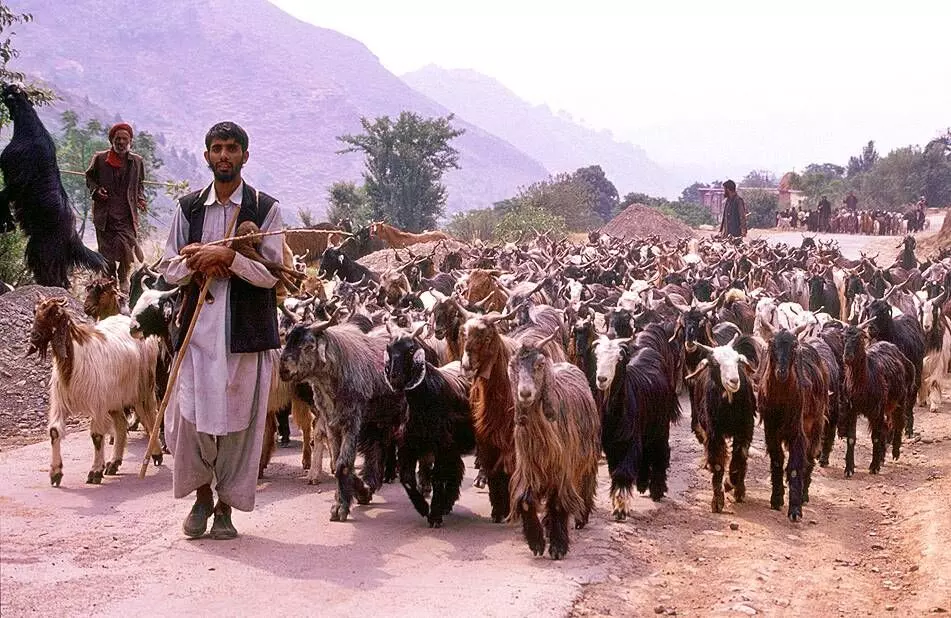The Bakarwals of Jammu & Kashmir are in the throes of transition
In a village near Jammu, members of the nomadic Bakarwal tribe prepare to travel to the upper reaches of Kashmir along with their livestock. But not all of them will as many young people are breaking away from their nomadic past to look for better livelihoods elsewhere.
 Aditi Kashyap and Nameera Anjum 5 May 2023 12:49 PM GMT
Aditi Kashyap and Nameera Anjum 5 May 2023 12:49 PM GMT

The Bakarwals are a subset of a larger ethnic group of the Gujjars, who inhabit parts of Northern India, Pakistan, and Afghanistan.
Pattian (Jammu), J&K
Shareefa smiled fondly as she watched her grandchildren playing noisily outside her home in Pattian village, bordering Jammu city. She belongs to the Bakarwal community and speaks a dialect that is a mix of Urdu and Gojri.
“We are a true nomadic community and keep moving from place to place all through the year. Our life revolves around our cattle,” she told Gaon Connection. She and her family spend the winter season in Pattian near Jammu and migrate to Srinagar-Pahalgam in the summer months.
“When we need money we sell the animals [goat and sheep] sometimes,” she added. She was not sure, but Shareefa said she was in her fifties.
It is a difficult life for the Bakarwal community, a scheduled tribe in Jammu & Kashmir. Many of the tribe members, such as Shareefa, are unaware of government schemes for their welfare. Shareefa’s four sons had moved away to other parts of the Union Territory, in search of jobs that brought in more money.
“One of my sons is a gardener and the other is a driver. The money they make all goes into educating my grandchildren,” she added. She lived with her husband and daughter-in-law, and her grandchildren. Her husband looked after their cattle.
Also Read: Left out in the cold: The Chopan shepherds of Jammu & Kashmir are without identity or many rights
The Bakarwals are a subset of a larger ethnic group of the Gujjars, who inhabit parts of Northern India, Pakistan, and Afghanistan. According to the 2011 Census, approximately 1.5 million Gujjars and Bakarwals live in Jammu, Kashmir, and Ladakh, accounting for around 11.9 per cent of the region's total population.
The 810,800 Gujjar and Bakarwals make up more than 54 per cent of the tribal population of Jammu. In Jammu and Kashmir, they practise Islam and they were designated as Scheduled Tribe in 1991.
According to the 2011 Census, approximately 1.5 million Gujjars and Bakarwals live in Jammu, Kashmir, and Ladakh, accounting for around 11.9 per cent of the region's total population.
Herding livestock is the main source of livelihood for the Bakarwal community. Members of the nomadic community move to Jammu during the cold winter months and travel back to the upper reaches of the mountains in Kashmir during the warmer months with their goat and sheep looking for pasture.
There are about five to six Bakarwal families in Pattian village, all living close to one another. Many of them are elders along with a smattering of younger people and some infants.
Reshma Bibi lives in the neighbourhood of Shareefa. She lives in Pattian along with her youngest son and grandson, baby Asim. Her son, while looking after livestock, also hires himself out as a driver.
“I have been travelling across Jammu and Kashmir all my life. Not any more as I am much older now, and my body cannot take the strain so much,” she told Gaon Connection. But, back in the day, Reshma Bibi would migrate from lower reaches to upper and back on foot or sometimes on horseback, she said.
Herding livestock is the main source of livelihood for the Bakarwal community.
But, the lifestyle of the community is slowly but surely changing. Political unrest, border aggression and militancy have all taken their toll on the close-knit nomadic community. And, many of the younger members are breaking from tradition and moving away in search of other sources of livelihood.
Also Read: The ‘Seasonal Teachers’ of Kashmir brave snow, dense forests and an inhospitable terrain
“I will not be travelling back to Srinagar in the summers. My mother-in-law will travel but I am staying back with my son who is preparing for NEET, and my daughter who is in her ninth,” Praveena, who is in her 30s, and stays at Pattian, told Gaon Connection.
It is becoming obvious that traditional life habits are crumbling. While some of the older community members still cling to their old nomadic practices, the youth are slowly separating from their tribal roots and seeking employment elsewhere.
Bakerwal Kashmir Tribal
More Stories




